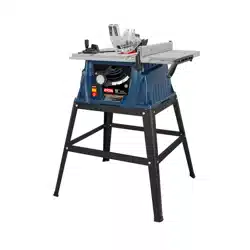Loading ...
Loading ...
Loading ...

TO MAKE A BEVEL RIP CUT
It is recommended that you place the piece to be saved on
the right side of the blade and that you make a test cut on
scrap wood first.
_ WARNING: ]
The rip fence must be on the right side of the blade to
avoid trapping the wood and causing kickback.
WARNING: I
Make surethebladeguardassemblyissecurelyinstalled
and workingproperlyto avoidserious personalinjury.
1. Removethe miter gauge by sliding it out of the channel.
2. Position the rip fence the desired distance from the right
side of the blade and lock down the handle.
3. Adjust the bevel angle to the desired setting. See
page l&
4. Set the blade to the correct depth. See page 14.
5. If ripping a piece larger than 36" long, place a support
the same height as the table surface behind the saw for
the cut work.
6. Makesure that all looseitemshavebeen removed from
the table surface and that the workpiece is notin contact
with the blade.
7. Turn the On/Off switch to the On position.
8. Position the workpieca flat on the table with the edge
flushagainst the rip fence. Let the blade build up to full
speed before feeding the workpiece intothe blade.
9. Using a push stick and/or push blocks, slowly feed the
workpiece toward the blade. Stand slightly to the side of
the wood as it contacts the blade to reduce the chance
of injury should kickback occur.
10. Once the blade has made contact with the workpieca,
use the hand closest to the rip fence to guide it. Make
sure the edge of the workpieca remains in solid contact
with both the rip fence and the surface of the table. If
ripping a piece narrower than 4", use a push stick to
move the piece through the cut and past the blade.
11. Continue to feed the workpiece into the blade until the
cut has been completed.
12. Grasp the workpieca from the lead end (the end that
was fed into the bladefirst)and carefully removeitfrom
the table.
13. Turn the On/Off Switch to the Off position.
14. After the blade has stopped completely, remove the cut-
off stock.
TO MAKE A COMPOUND MITER CROSS CUT
It is recommended that you place the piece to be saved on
the left side of the blade and that you make a test cut on
scrap wood first.
l, WARNING: I
Make surethebladeguardassemblyissecurelyinstalled
and workingproperlyto avoidseriouspersonalinjury.
1. Remove the rip fence by lifting the lock down handle.
2. Adjust the bevel angle to the desired setting. See
page 13.
3. Set theblade tothe correct depth. See page 14.
4. Loosenthe lock knob on the mitergauge, set the miter
gauge to the desired angle and tighten lock knob.
5. Make sure that all loose items have been removed from
the table surface and that the workpiece isnot in contact
with the blade.
6. Turn the On/Off Switch to the On position.
7. Position the workpieca fiat on the table with the edge
flush against the miter gauge. Let the blade build up to
full speed before feeding the workpiece into the blade.
8. Use two hands to slowly advance the workpiece and the
miter gauge toward the blade. Use the hand furthest from
the blade to keep the workpieca flush against the miter
gauge. Use the other hand to push the miter gauge and
workpieca toward the blade. Stand slightly to the side of
the wood as it contacts the blade to reduce the chance
of injury should kickback occur.
9. Continue to feed the workpiece into the blade untilthe
cut has been completed.
10. Once the cut is complete, pull the workpiece away from
the blade and back toward you.
11. Turn the On/Off Switch to the Off position.
12. After the blade has stopped completely, remove the cut-
off stock.
TO MAKE NON-THROUGH CUTS
Non-threugh cuts can be made with the grain (ripping) or
acrossthegrain (crosscut). Non-throughcutsare essential
incuttinggrooves,rabbets,anddadoes.Thisistheonlytype
of cut made with the blade guard assembly removed. You
must make sure the entire blade guard assembly is re-
installed properlyupon completionof thistypeofcut.
In additionto thissection,make sure to readthe sectionon
thespecifictypeofnon-throughcutbeingmade. Forexample,
ifyournon-threughcut isa cresscut, read and understand
the sectionon crosscutsthoroughlybeforeproceeding.
IA WARNING: I
Unplugthesaw to avoidseriouspersonal injury. |
!
Page 18
Loading ...
Loading ...
Loading ...
